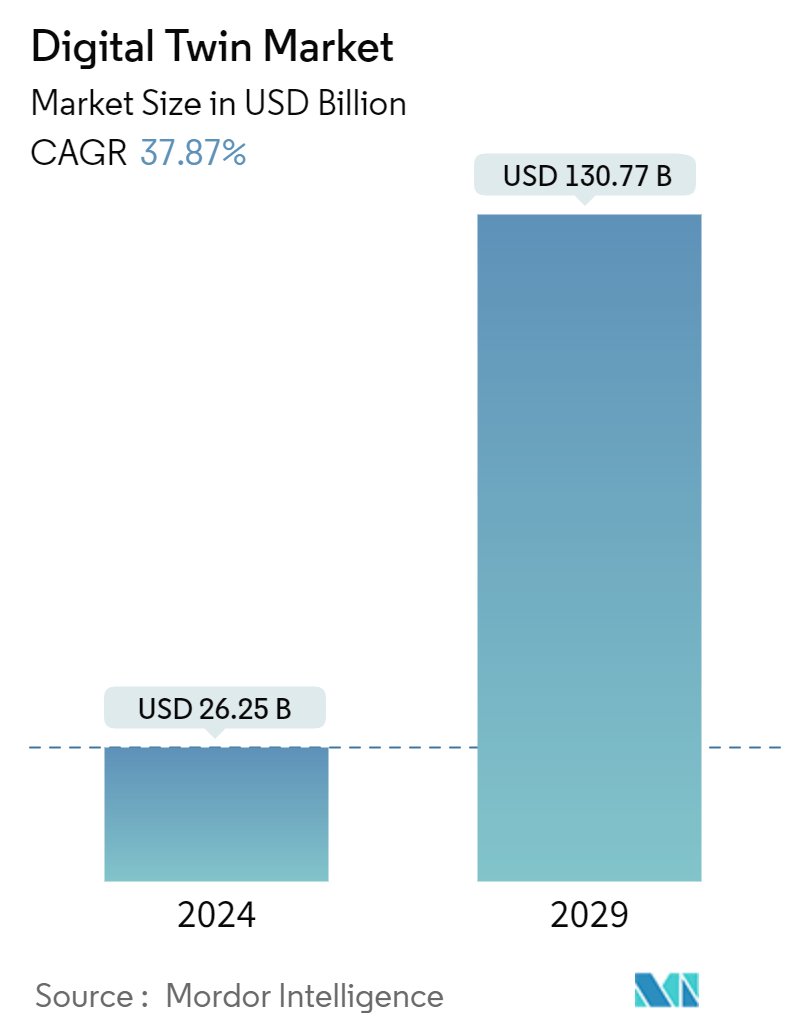Market Size of Digital Twin Industry

| Study Period | 2019 - 2029 |
| Market Size (2024) | USD 26.25 Billion |
| Market Size (2029) | USD 130.77 Billion |
| CAGR (2024 - 2029) | 37.87 % |
| Fastest Growing Market | Asia Pacific |
| Largest Market | North America |
| Market Concentration | Low |
Major Players
*Disclaimer: Major Players sorted in no particular order |
Digital Twin Market Analysis
The Digital Twin Market size is estimated at USD 26.25 billion in 2024, and is expected to reach USD 130.77 billion by 2029, growing at a CAGR of 37.87% during the forecast period (2024-2029).
- The adoption of digital twin technology witnessed significant growth due to the COVID-19 pandemic. Constrained by social distancing and travel limitations, businesses increasingly turned to digital twins for remote process monitoring and optimization. The healthcare sector also witnessed a sharp rise in the use of digital twins to simulate patient flows and enhance resource allocation in hospitals. This heightened interest in digital twins was not limited to healthcare. Factories also embraced the technology to manage production lines and ensure workers’ safety.
- Digital twins incorporate artificial intelligence (AI), Big Data, machine learning (ML), and the Internet of Things (IoT) in Industry 4.0 and are predominantly used in the industrial Internet of Things (IIoT), engineering, and manufacturing business space. The widespread usage of IoT has made digital twin technology more cost-effective and accessible for the business world.
- The growth in the use of digital twins is anticipated to transform the manufacturing processes and offer innovative approaches to reducing costs, optimizing maintenance, monitoring assets, reducing downtime, and creating new connected products. Although not new, the digital twin model has been entering manufacturing and other industries rapidly. Technologies such as IoT and cloud-based platforms have been major drivers for the increased adoption of digital twin solutions.
- The market’s growth is expected to be hampered by the presence of traditional systems used in underdeveloped countries. Most of these legacy systems had already been developed but were primarily designed and built to function without connectivity. They cannot incorporate advanced sensor technology that offers real-time data, limiting the adoption of advanced technologies.
- However, post-pandemic, companies are increasingly turning to digital twins to model and enhance their operational resilience. This proactive approach helps them craft robust response and recovery strategies, better preparing them for future market disruptions.
Digital Twin Industry Segmentation
A digital twin is a virtual simulation that accurately replicates a physical object. The digital twin market has been defined based on the revenues generated from the software and services used in various applications such as oil and gas, manufacturing, automobile, aerospace, and other end users around the globe.
The digital twin market is segmented by application (manufacturing, energy and power, aerospace, oil and gas, automobile, and other applications) and geography (North America [United States, Canada], Europe [United Kingdom, Germany, France, and the Rest of Europe], Asia-Pacific [China, Japan, India, and the Rest of Asia-Pacific], and the Rest of the World). The market sizes and forecasts are provided in terms of value in USD for all the above segments.
| By Application | |
| Manufacturing | |
| Energy and Power | |
| Aerospace | |
| Oil and Gas | |
| Automobile | |
| Others Applications |
| By Geography*** | |||||
| |||||
| |||||
| |||||
| Australia and New Zealand | |||||
| Latin America | |||||
| Middle East and Africa |
Digital Twin Market Size Summary
The digital twin market is experiencing rapid expansion, driven by the integration of advanced technologies such as artificial intelligence, big data, machine learning, and the Internet of Things within the framework of Industry 4.0. This technology has gained significant traction across various sectors, including manufacturing, healthcare, and aerospace, particularly following the COVID-19 pandemic, which highlighted the need for remote monitoring and optimization solutions. Digital twins are increasingly being utilized to enhance operational efficiency, reduce costs, and improve asset management by creating virtual replicas of physical systems. The technology's ability to facilitate real-time data analysis and predictive maintenance is transforming manufacturing processes and enabling companies to develop more connected and innovative products. Despite the challenges posed by legacy systems in underdeveloped regions, the market is poised for substantial growth as industries continue to embrace digital transformation.
The market's expansion is further supported by the growing adoption of IoT devices and advancements in AI, which enable more detailed and real-time data collection essential for accurate digital twin creation. Regions such as North America are witnessing significant investments in digital twin technology, driven by the manufacturing sector's need for advanced prototyping and testing solutions. The involvement of major players like IBM, Siemens, and Microsoft, along with strategic collaborations and acquisitions, is enhancing the market's competitive landscape. These companies are leveraging digital twin technology to revolutionize supply chain and manufacturing processes, indicating a robust future for the market. As sectors like healthcare, aerospace, and renewable energy continue to explore and implement digital twin solutions, the market is expected to capture substantial growth opportunities in the coming years.
Digital Twin Market Size - Table of Contents
-
1. MARKET INSIGHTS
-
1.1 Market Overview
-
1.2 Industry Attractiveness - Porter's Five Forces Analysis
-
1.2.1 Bargaining Power of Suppliers
-
1.2.2 Bargaining Power of Consumers
-
1.2.3 Threat of New Entrants
-
1.2.4 Threat of Substitutes
-
1.2.5 Intensity of Competitive Rivalry
-
-
1.3 Industry Value Chain Analysis
-
1.4 Assessment of the Impact of COVID-19 on the Industry
-
-
2. MARKET SEGMENTATION
-
2.1 By Application
-
2.1.1 Manufacturing
-
2.1.2 Energy and Power
-
2.1.3 Aerospace
-
2.1.4 Oil and Gas
-
2.1.5 Automobile
-
2.1.6 Others Applications
-
-
2.2 By Geography***
-
2.2.1 North America
-
2.2.1.1 United States
-
2.2.1.2 Canada
-
-
2.2.2 Europe
-
2.2.2.1 United Kingdom
-
2.2.2.2 Germany
-
2.2.2.3 France
-
-
2.2.3 Asia
-
2.2.3.1 China
-
2.2.3.2 Japan
-
2.2.3.3 India
-
-
2.2.4 Australia and New Zealand
-
2.2.5 Latin America
-
2.2.6 Middle East and Africa
-
-
Digital Twin Market Size FAQs
How big is the Digital Twin Market?
The Digital Twin Market size is expected to reach USD 26.25 billion in 2024 and grow at a CAGR of 37.87% to reach USD 130.77 billion by 2029.
What is the current Digital Twin Market size?
In 2024, the Digital Twin Market size is expected to reach USD 26.25 billion.

